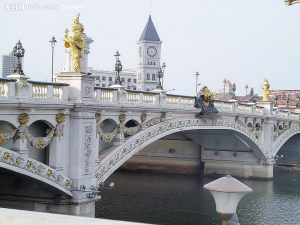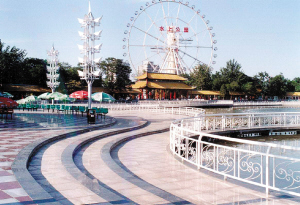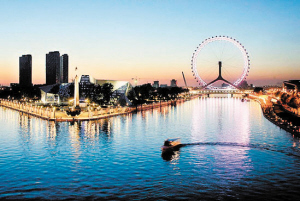|
 |
| The Haihe River | Most travelers who have been to Tianjin before find the city to be much cleaner and prettier this summer.
Tianjin’s rapid development in recent years has made it a super construction site. New projects beginning every day not only bring benefits but also dust clouds.
To improve its environment, Tianjin launched a 150-day campaign on March 1, 2009 aimed at building Tianjin into “one of China’s cleanest and prettiest cities”.
This is the second such campaign for the city, having launched one on March 1 last year in preparation for the 2008 Olympic Games, as Tianjin was a co-hoster of the Games.
During this year’s campaign, over 200 factories with serious pollution problems were required to cut emissions or move out of the downtown area. Coal-fired boilers were upgraded to reduce dust, vehicles discharging pollutants that exceed stipulated standards were forbidden to operate on roads and more new buses and taxis went into operation.
The press spokesman of the municipal government, Liu Jiangang, said Tianjin will focus on the construction of large high-quality projects and avoid small projects that consume energy excessively and pollute heavily.
"Tianjin aims not only for high quantity in development, but also for high quality," said Liu.
Besides the improvement in air quality, the qualification rate of Tianjin’s drinking water has been 100% for six consecutive years, thanks to the government’s 2.4 billion yuan investment on protecting the city’s water resource—the Luan River.

The city also plans to set up three recycling water plants this year to ensure 30% of the city’s reclaimed wastewater will be reused, as Tianjin is short of water resources. The per capita water share is 160 cubic meters, 7% of the national level.
A green belt along the Haihe River, the main river running through downtown Tianjin, has been built, offering local residents a new leisure place. And nine parks free to visitors have opened after a complete renovation.


Tianjin also made efforts to ease its transportation pressure, which was a bottleneck to its development. It plans to construct nine subway lines and one light rail, totaling 227 kilometers.Subway line one has already been operating for three years; three lines are currently under construction and two lines will begin construction within the year.
Tianjin party chief Zhang Gaoli pointed out that a good living environment is both a sign for a modern international metropolis and an asset for attracting talents and investment.
The environment not only concerns the image of Tianjin, but also people’s life quality and the city’s competitiveness, he added.
By Guo Changdong
|

